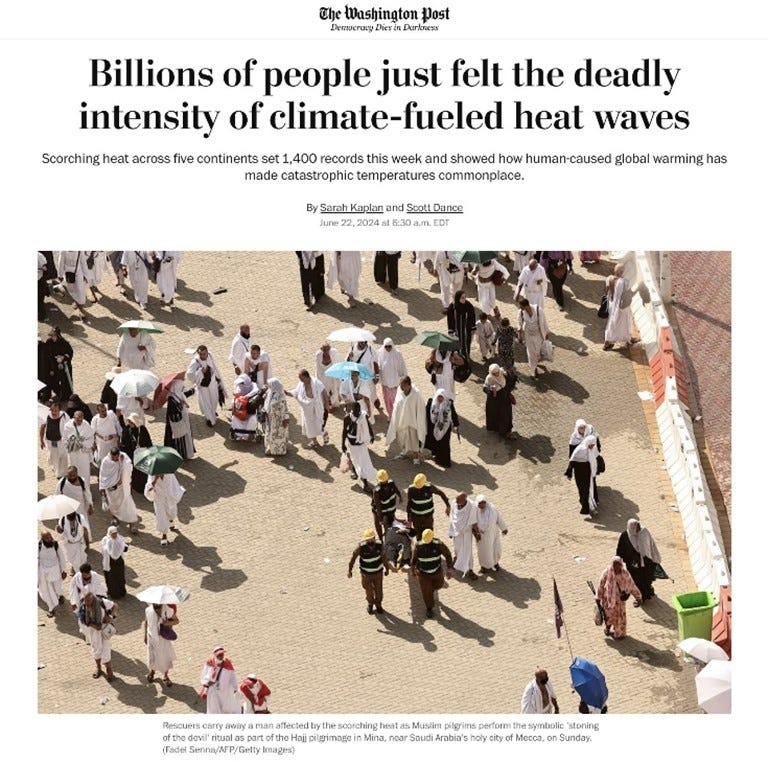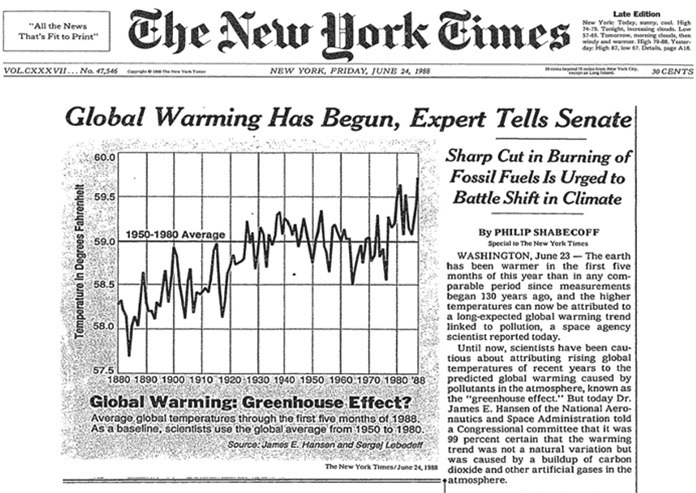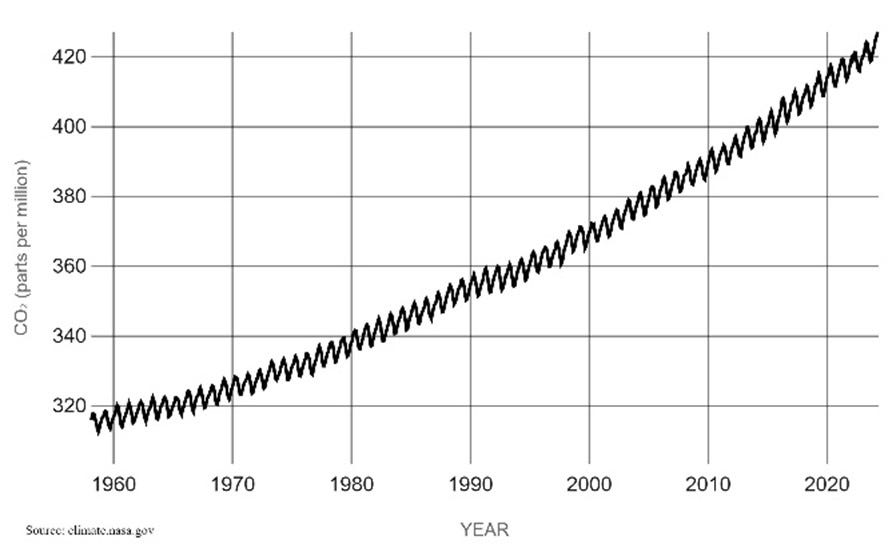Decades of warning and inaction
The last ten years have been the hottest on record. By the middle of June 2024, more than 1,400 temperature records had been broken worldwide. Between 14 and 19 June, at least 1,300 people on the Hajj pilgrimage to Mecca died due to temperatures exceeding 122° F. In May, the atmospheric concentration of CO2 climbed to 427 parts per million (ppm),1 22% higher than 350 ppm considered safe. Methane levels are also rising, and methane is more than 28 times as potent as carbon dioxide at trapping heat in the atmosphere.2
None of this should come as a surprise. Scientists have long warned about the climate-destabilizing effects of greenhouse gases released by humans burning fossil fuels. The most dramatic of such warnings came in the summer of 1988. On June 23, 1988, James Hanson, the director of NASA’s Goddard Institute for Space Studies, appeared before the Senate Committee on Energy and Natural Resources. The impetus for his testimony was the unusually hot and dry summer around the world. In the United States temperatures in the South and the Midwest were consistently in the 90s, reaching 105° as far north as Madison Wisconsin. The Mississippi River was at its lowest level in one hundred years. Before the summer was over, fires would consume one-third of the Yellowstone National Park. On that day the temperature in Washington DC was a record 98 degrees. For those who were there, it felt like 102° F degrees. In his opening statement, Dr. Hanson presented scientific data to reach three conclusions: 1. The world is getting warmer and more rapidly compared to any previous recorded period. 2. Temperature increases are consistent with the greenhouse effect. 3. Unless drastic cuts in greenhouse gases are made, temperatures will continue to climb, resulting in increased frequency of extreme weather events such as heatwaves and droughts.3 As years turned into decades, Hanson’s predictions proved eerily accurate.
ttps://babel.hathitrust.org/cgi/pt?id=uc1.b5127807&view=1up&seq=54
The testimony drew the attention of the media. Major newspapers covered it prominently on their cover pages. The New York Times warned of the start of global warming. Global warming, however, had already begun decades earlier.
The role of greenhouse gases in causing the warming of the earth’s temperatures had been known for over a hundred years before James Hanson’s Senate testimony. In 1856, the American scientist Eunice Foote first showed that atmospheric CO2 absorbs heat from sunlight. Three years later, Irish physicist John Tyndall demonstrated the absorptive strength of various gases in the atmosphere, thus proving what later was termed the greenhouse effect. In 1896, the Swedish scientist Svante Arrhenius argued that CO2 emitted through industrial production could change global temperatures, although he assumed the change would take centuries to happen. In 1938, Guy Stewart Callendar showed that the earth's temperature had increased since the 1880s. In the late 1950s Charles Keeling, an American scientist, was the first to document the relationship between increased CO2 levels due to fossil fuel emissions and increased temperatures as well as seasonal variations in CO2 levels. In 1965 the President’s Science Advisory Committee Report warned of a 25% increase in atmospheric CO2 by the year 2000 that could increase average temperatures near the Earth’s surface, the melting of the Antarctic ice cap, sea-level rises, acidification, and warming of the oceans. The 1983 EPA report, “Can We Delay Greenhouse Warming” analyzed the feasibility of several policy options ranging from fuel taxes to fossil fuel bans. The report predicted a warming of 2 degrees Celsius by the middle of the 21st century, stating that “the shift away from fossil fuels perhaps could be instituted more gradually and therefore less expensively if energy policies were adopted now rather than several decades later.” The report’s warning of catastrophic warming of the earth made it to the TV network news.
The Reagan administration dismissed it as “unnecessarily alarmist,” the harbinger of what was coming to be referred to as climate change denialism.
In the subsequent decades, despite regular scientific reports about the risks of fossil fuel emissions to the very existence of life on earth, emissions have continued to grow and with them the global average temperatures.
https://svs.gsfc.nasa.gov/vis/a000000/a005200/a005207/2023GISTEMP_Map_HD.mp4
While fossil fuel companies have rightfully faced significant criticism for their disregard for the planet's survival, we must also consider the responsibility of other large corporations. These companies, for whom a carbon-free world is not an existential threat, have had over thirty-five years to transform their operations to zero emissions and zero waste. They have largely failed to do so year after year despite the abundance of knowledge about the causes and consequences of climate change and what needs to be done to limit the damage their companies are continuing to inflict on the environment and their net-zero pledges. How seriously should we take corporate sustainability claims? That is the topic of my next blog.
See here for a list of Dr. Hanson’s testimonies to Congressional committees in the 1980s: https://www.sealevel.info/1988_Hansen_Senate_Testimony.html )






